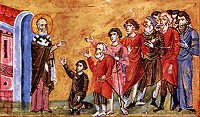 |
|
 |
Paroikoi: the landless and the poor
 he common workers must have formed a special group of dependent manpower.
he common workers must have formed a special group of dependent manpower.
 They too were counted among the paroikoi of a landowner, but were differentiated from the rest because they were landless and indigent and worked for a wage. In documents of the time they are referrred to as
aktemones, misthioi douleutai or douleutai, douleutai paroikoi or douleutoparoikoi,
in order to make it clear that they owned very little or no property of any kind, that is neither land nor livestock, as did the paroikoi. They too were counted among the paroikoi of a landowner, but were differentiated from the rest because they were landless and indigent and worked for a wage. In documents of the time they are referrred to as
aktemones, misthioi douleutai or douleutai, douleutai paroikoi or douleutoparoikoi,
in order to make it clear that they owned very little or no property of any kind, that is neither land nor livestock, as did the paroikoi.
Their main characteristic was their poverty, which many times bordered on abject misery. They found refuge and work in the service of the great landowners or the monasteries, where they could cultivate the land as tenants or provide manpower for various jobs. They were not registered on tax lists and thus had the possibility of remaining in a certain area for a short period of time. If, however, after a period of thirty years, they still remained on a particular land, they were not allowed to refuse to work and to stop providing service. Those who cultivated the land as tenants for thirty years, became, according to the law, paroikoi, that is permanent tenant-farmers.
As regards their legal and social status, opinions differ. It has been claimed that their position was actually that of a kind of slave. This confusion has arisen because of the sense attributed to the word "douleuo" in combination with the above-mentioned terms - "douleutai", "douleutai paroikoi" and "douleutoparoikoi". But since the verb "douleuo" had already, since the 13th century, been used in the current sense "to work" and was no longer connected to the term "douleia" ("slavery"), the view arguing that this social group simply consisted of ordinary labourers occupying a very low social position seems more valid.
It is worth noting that, in the society of the late Byzantine period, there were no Christian slaves, although they had existed as a distinct class in earlier periods.
|